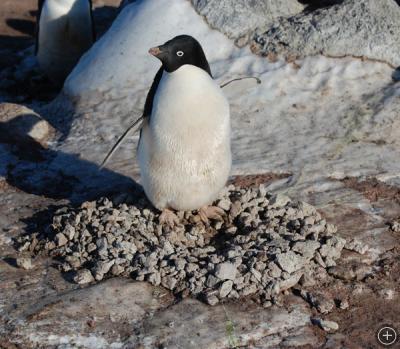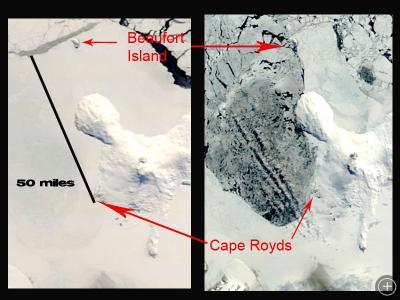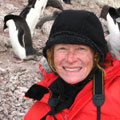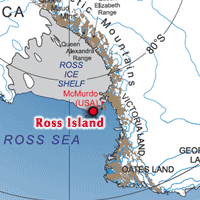What a Difference a Year Makes
CAPE ROYDS, ROSS ISLAND, ANTARCTICA– The picture below shows the difference between the ice edge on November 3, 2008 (left) and November 3, 2009 (right) for the Ross Island area. For the penguins at Cape Royds this meant 50 miles less ice to walk over in order to arrive at their breeding colony. As penguins would much rather swim than walk, this was good news. I expected to see penguins arriving earlier than last year and in greater numbers, perhaps building their nests and laying their eggs earlier.
At Cape Royds we have a ‘penguin cam’ which is a permanent structure housing a remote camera. The camera takes a picture of the colony every day as long as the solar panels generate the power to keep the batteries charged. Since the research team is not in the field all year round, this allows us to monitor what is happening at the colony when we’re not here. You can see the daily pictures at http://penguinscience.com, as well as a time-lapse of images taken over the last two years. Last year and this year the first penguins were seen the last week of October, so not much changed there, but there were fewer birds and nests being built during the first weeks this season. When we started looking for eggs the picture became even more surprising.
In 2008 the first eggs were seen on November 5th. This year we did not see eggs until November 16th. Plus the number of birds present in the colony continued to stay low. Something was keeping the penguins from arriving, building their nests and laying their eggs on the normal schedule. As the days progressed more birds started showing up and by November 25th the colony looked busy, with many nests completed and females leaving for open ocean to replenish their energy and become fat again.

An early arrival at the colony. He could have all the stones he needed so he built a large nest. Now he waits for the female to show up and guards his rocks from other males as they arrive.
The breeding season in Antarctica is very short. Adélie penguin chicks must gain the weight they need to sustain themselves through their molt to adult plumage before they are able to swim and find their own food. If the sea ice closes in around Ross Island before this happens they will have a huge task walking to open water and food. They can not swim until they have their adult plumage. We do not know what will happen this season, but that is why we are here so we can observe and record this event. We are hoping you will follow along as well.
Did you know that penguin researchers also use the satellites to track penguins when they are out in the open ocean foraging for food? See how they do this here.
Learn more about Adélie penguins at www.penguinscience.com












Loved the article and very cool pictures of the penigun!
Wow I love those pictures.. I never knew that satellites are used to track penguins. In Penguin Science website, the satillete video showing penguins and their acts is great.
Good article.